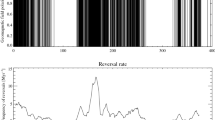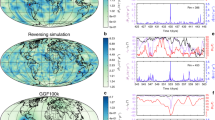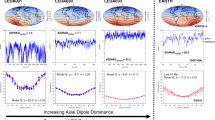Abstract
A PRIMARY task of geomagnetism is to account for the magnetic field of the Earth and for the occasional reversals of that field. Present research in geomagnetic dynamo theory aims to develop a physically realistic, mathematically solvable, self-reversing dynamo model1—one that contains the seeds of its own reversal. Here I point out that there is an alternative method of analysing the geomagnetic field which can account for magnetic reversals but which does not require a self-reversing dynamo. The analysis is based on the assumption that the geomagnetic field arises from two separate sources. Each source has a mathematical representation in terms of dipoles, quadrupoles, and so on. The magnetic field which is observed at or above the surface of the Earth is the sum of the fields arising from the two sources: in particular, the observed dipole component of the Earth's field is the vector sum of the dipole components of each source  If the dipole components of each source are oppositely directed, one pointing essentially towards the north rotational pole and the other essentially towards the south rotational pole, then
If the dipole components of each source are oppositely directed, one pointing essentially towards the north rotational pole and the other essentially towards the south rotational pole, then  The prevailing magnetic polarity reflects the polarity of the dominant source component (Fig. 1). A magnetic reversal, which corresponds to a change in the sign of M0, represents a shift in the relative sizes of M1 and M2. If both M1 and M2 are very large compared with M0, then only small fluctuations in M1, M2, or both will result in a reversal.
The prevailing magnetic polarity reflects the polarity of the dominant source component (Fig. 1). A magnetic reversal, which corresponds to a change in the sign of M0, represents a shift in the relative sizes of M1 and M2. If both M1 and M2 are very large compared with M0, then only small fluctuations in M1, M2, or both will result in a reversal.
This is a preview of subscription content, access via your institution
Access options
Subscribe to this journal
Receive 51 print issues and online access
$199.00 per year
only $3.90 per issue
Buy this article
- Purchase on Springer Link
- Instant access to full article PDF
Prices may be subject to local taxes which are calculated during checkout
Similar content being viewed by others
References
Gubbins, D., Revs Geophys. Space. Phys., 12, 137–154 (1974).
Rikitake, T., Proc. Cambridge phil. Soc., 54, 89–105 (1958).
Rikitake, T., Geophys. J. R. astr. Soc., 35, 277–284 (1973).
Wilson, R. L., Geophys. J. R. astr. Soc., 28, 295–304 (1972).
Dagley, P., and Lawley, E., Geophys. J. R. astr. Soc., 36, 577–598 (1974).
Phillips, J., and Cox, A., EOS Trans. AGU, 56, 1109 (1974).
Verosub, K. L., Geophys. J. R. astr. Soc. (in the press).
Bolt, B., Bull. seis. Soc. Am., 54, 191–208 (1964).
Julian, B. R., Davies, D., and Sheppard, R. M., Nature, 235, 317–318 (1972).
Higgins, G., and Kennedy, G. C., J. geophys. Res., 76, 1870–1878 (1971).
Ashcroft, N., Phys. Rev. Lett., 21, 1748–1749 (1968).
Author information
Authors and Affiliations
Rights and permissions
About this article
Cite this article
VEROSUB, K. Alternative to the geomagnetic self-reversing dynamo. Nature 253, 707–708 (1975). https://doi.org/10.1038/253707a0
Received:
Published:
Issue Date:
DOI: https://doi.org/10.1038/253707a0
This article is cited by
-
The stability of the earth's core and the geodynamo
Nature (1976)
Comments
By submitting a comment you agree to abide by our Terms and Community Guidelines. If you find something abusive or that does not comply with our terms or guidelines please flag it as inappropriate.



